Blossoming at the Rose Theatre
The Rose playhouse was the first purpose-built theatre south of the Thames to be located on Bankside, Southwark.
The playhouse was erected by Philip Henslowe in 1587 and functioned for a couple of decades on the north side of Maiden Lane (now Park Street).
-
![]()
Much ado near me
Hear more Shakespeare stories on BBC Radio London
-
![]()
Shakespeare Festival 2016
The BBC celebrates the genius of the bard
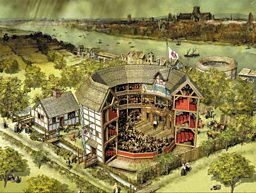
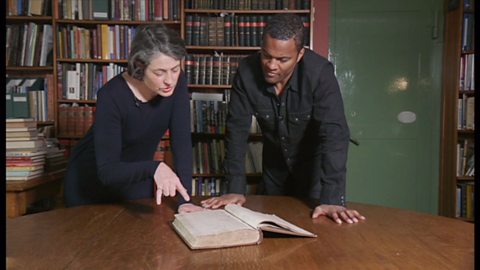
Shakespeare's career takes off in London at the Rose Theatre
Harry Potter and Coronation Street's Ray Fearon discovers more about the historic venue
Strange's Men at the Rose
The first acting company known to have been in residence at the Rose was an innovative and talented troupe under the patronage of Ferdinando Stanley, Lord Strange, the heir of the 4th Earl of Derby.
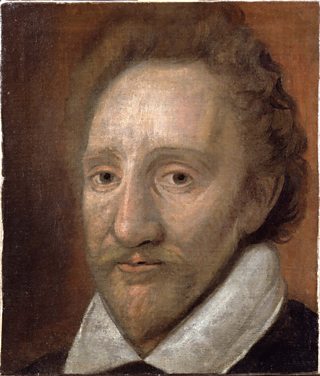
Thanks to the unique survival of the journal known as Henslowe’s Diary we can track the performances (and receipts) by play at the Rose during two seasons when Strange’s Men maintained residence (from 19 February-22 June 1592, and again from 29 December 1592-1 February 1593).
Actor Edward Alleyn was the star performer, and although we have no actual record that Shakespeare himself was a member of Strange’s Men, it is possible that he was indeed one of their hired actors at the time, as well as a contributing playwright.
Will Kemp, Thomas Pope and George Bryan, three leading members of Strange’s Men, migrated to join Shakespeare and Richard Burbage in the newly formed Chamberlain’s Men after the sudden death of their patron, Ferdinando Stanley (briefly 5th Earl of Derby) in the spring of 1594. All three would have been known to Shakespeare already, at least as actors in Henry VI, Part I during their heyday with Strange’s Men.
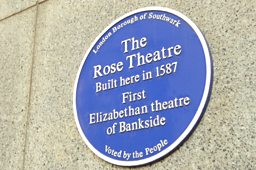
The summer 'plague' tour of 1592
In the summer of 1592, when Henry VI Part I was performing early in the year at the Rose Theatre, Lord Strange’s Men - the premier performing troupe on London - were forced to go on a provincial tour.
It is most unlikely that props and costumes for 24 plays would have been taken on foot, with only a wagon for transport
This was due to the closure of the capital’s main theatres, firstly as result of an apprentices’ riot in Southwark in June that drew the ire of the Privy Council, and then as plague became endemic in the city of London later the same summer.
Their tour took them first along a circuit south-east of London to Maidstone, Rye, Folkestone, Canterbury, and Faversham in June and July, and then along a western route to Bristol, Gloucester, Oxford and Coventry, swinging back for a stop in Cambridge before their return to perform three plays at Hampton Court during the Christmas season.
We see details of the tour registered in the records – usually town halls or the like - however, town accountants almost never recorded the titles of plays performed so we can only speculate on the repertory that they may have taken on tour.
It is most unlikely that props and costumes for 24 plays would have been taken on foot, with only a wagon for transport, by Strange’s Men this year, but their current hit, Henry VI Part I, would seem an ideal choice for that tour.
At Coventry especially, it would have found a perfect setting in St Mary’s Guildhall where a magnificent late 15th c. tapestry and stained glass window commemorating Henry VI and his lineage would have formed the setting behind the mayor and council at the high end, as they still do today.

Edward Alleyn and Dulwich College
Edward Alleyn was one of the star actors in the Elizabethan theatre, associated with both Lord Strange’s Men at the height of their success in the early 1590s and then with the Lord Admiral’s Men at the Rose and the Fortune before he retired from the stage to continue his own business interests.
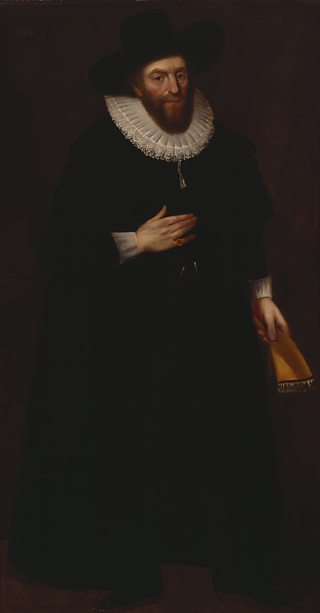
Alleyn thrived financially, with rising social status, and through his wife Joan ultimately gained the bulk of theatre entrepreneur Philip Henslowe’s estate and sole ownership of his theatres.
He acquired extensive properties in Surrey and in 1619 founded Dulwich College on his estate.
The Jacobean building was replaced by an even grander school in Victorian style, which maintains its reputation as a vibrant educational institution today.
It was founded on June 21st 1619, with letters patent from King James I. This magnificent document with the Great Seal of England still survives.
Today the college boasts: "We are able to transform the multi-functional and versatile Edward Alleyn Theatre to enable boys to explore varied approaches to the actor audience relationship. Boys have the opportunity not only to act but also direct, design, build and work as part of a creative team, providing lighting, sound and stage management."
Shakespeare interviewed as government official investigates play’s authorship
Records clearly show that William Shakespeare’s Titus Andronicus was performed at the Rose Theatre in 1594.
The play which had preceded this performance was the lesser known George a Green, Pinner of Wakefield.
That same year, Titus Andronicus was printed, together with some information about its performance history - though without the name of its author.
Five years later, in 1599, George a Green, Pinner of Wakefield also went into publication – but again there was no name for the author.
It was around this time that a certain George Buc, soon to become Sir George Buc and Master of the Revels, acquired a copy of the new book and tried to establish the name of the author.
As part of his investigations he consulted two members of the theatre profession – Edward Juby and William Shakespeare.
Buc wrote notes in his copy of the book, Shakespeare was able to remember that the author was a minister who had acted the part of Pinner himself. Shakespeare could clearly not recall the author’s name because Buc left a space blank against his Shakespeare notes; but Edward Juby – a member of the Admiral’s Men group of actors at the time, identified the author as Robert Green.
George Buc’s copy of George a Green, Pinner of Wakefield, still survives in the Folger Shakespeare Library in Washington D.C., complete with the notes from his personal interview with William Shakespeare.
Shakespeare on Tour
From the moment they were written through to the present day, Shakespeare’s plays have continued to enthral and inspire audiences. They’ve been performed in venues big and small – including inns, private houses and emerging provincial theatres.

BBC English Regions is building a digital picture which tracks some of the many iconic moments across the country as we follow the ‘explosion’ in the performance of The Bard’s plays, from his own lifetime to recent times.
Drawing on fascinating new research from Records of Early English Drama (REED), plus the British Library's extensive collection of playbills, as well as expertise from De Montfort University and the Arts and Humanities Research Council, Shakespeare on Tour is a unique timeline of iconic moments of those performances, starting with his own troupe of actors, to highlights from more recent times. Listen out for stories on Shakespeare’s legacy on your BBC Local Radio station from Monday 21 March, 2016.
You never know - you might find evidence of Shakespeare’s footsteps close to home…
Craig Henderson, BBC English Regions
Henslowe’s amazing diary by Sally-Beth MacLean, REED General Editor
One of the most remarkable survivals from the Shakespearean era is Philip Henslowe’s diary – really a memorandum book in which the theatre entrepreneur made rough jottings about the theatre business, including playhouse repairs, income from play performances, loans to actors and playwrights, and other miscellaneous accounts.
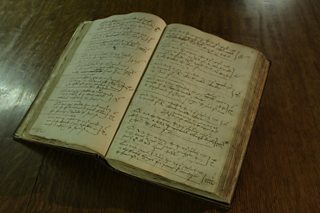
Henslowe erected the Rose, the first theatre in Southwark, by 1587 and soon thereafter established a close relationship with Lord Strange’s Men, the troupe that soon became the premiere acting company based in London by 1590.
It is widely accepted that Shakespeare was writing plays for Strange’s Men by 1592 – the possibility that he also acted with the company at the time remains a subject for speculation though no one knows for sure how his acting career began.
Henslowe notes performances of ‘harey the vj’ (Henry VI) 17 times in the Diary between 3 March 1592 and 31 January 1593. Of the trilogy, Henry VI Part I is the play most commonly agreed to be a collaboration that included scenes written by Shakespeare.
Meantime, in signal of my love to thee,
Against proud Somerset and William Pole
Will I upon thy party wear this rose.
And here I prophesy: this brawl today,
Grown to this faction in the Temple garden,
Shall send, between the red rose and the white,
A thousand souls to death and deadly night.
- Henry VI, Part 1, Act 2, Scene 4, ll. 122-28
Henry VI Part I features the death of the English hero, John Talbot, played by Edward Alleyn at the time and saluted by Thomas Nashe in a prose work published later in 1592. Certainly ‘harey the vj’ was a hit at the Rose with Alleyn in the lead role: it was performed four times during its first two weeks in repertory and remounted frequently – and lucratively - thereafter.
The manuscript diary runs sporadically from 1592 to 1609 but Henslowe’s name surfaces in many other kinds of documents from the period – personal letters, property leases, court cases, contracts, royal appointments, even vestry minute books because he became a churchwarden at the parish church of St Saviour’s (now Southwark Cathedral) in 1608.
Many of Henslowe’s papers, along with those of his son-in-law - and star Elizabethan actor - Edward Alleyn, are now housed at Dulwich College, south of London, where they can be consulted by appointment – a fascinating treasure trove for anyone interested in Elizabethan theatre.
Praise indeed for Henry VI performance at the Rose
Henry VI Part I features the death of the English hero, John Talbot, played by famous Elizabethan actor Edward Alleyn at the time.

In 1592 it was performed four times at the Rose Theatre during its first two weeks in repertory and remounted frequently – and lucratively - thereafter.
The performance was saluted by writer Thomas Nashe in a prose work published later in 1592.
‘How would it have joyed brave Talbot (the terror of the French) to think that after he had lain two hundred years in his tomb, he should triumph again upon the stage and have his bones new embalmed with the tears of ten thousand spectators at least (at several times) who, in the tragedian that represents his person, imagine they behold him fresh bleeding.’
Thomas Nashe, Pierce Penilesse his Supplicacion to the Deuill, entered in the Stationers Register, 8 August 1592, just before publication.
Related Links
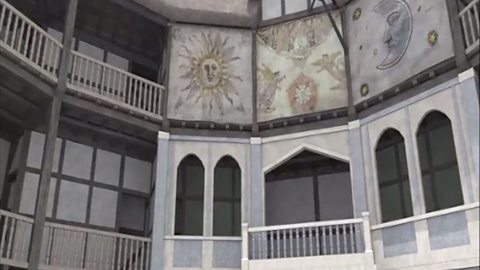
The Rose Theatre Reconstruction
(c) Rhys Griffin in association with 'The Lost Valley of London'
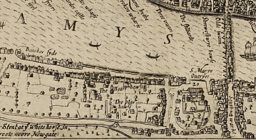
Shakespeare on Tour: Around London
-
![]()
The King's Men
When Shakespeare's players became the King's men and join the 1604 Coronation procession
-
![]()
The 1809 ticket price riots
The most famous riots in the history of theatre
-
![]()
The Lyceum Theatre performed Shakespeare in 1883
But which famous gothic writer worked here?
-
![]()
Charles Kean
The London theatre manager not lost for words
-
![]()
A historic performance of Coriolanus in London
The last performance of Coriolanus before the French Revolution
-
![]()
London's Female Romeo
Charlotte Cushman, who took Victorian London by storm
-
![]()
Curtains for London's Newington Theatre
The closure of London's first purpose built theatre south of the Thames
-
![]()
Shakespeare's Players turned away from Kingston
The actors paid not to perform
-
![]()
Shakespeare and the 'Night of Errors'
A series of unfortunate incidents at Gray Hall
Shakespeare on Tour: Around the country
-
![]()
Ipswich: a magnet for Shakespeare?
Why did Shakespeare's company visit Ipswich ten times?
-
![]()
Sarah Siddons visits Norwich
Putting the Theatre Royal, Norwich, on the map
-
![]()
Madame Tussaud's exhibiton in Nottingham
Including a model of William Shakespeare
-
![]()
Touring Kent to avoid the plague
In 1592, the plague forced touring theatre companies out of London















